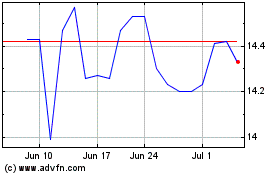Additional Proxy Soliciting Materials (definitive) (defa14a)
May 16 2018 - 9:08AM
Edgar (US Regulatory)
UNITED STATES
SECURITIES AND EXCHANGE COMMISSION
Washington, D.C. 20549
SCHEDULE 14A
Proxy Statement Pursuant to Section 14(a) of
the Securities Exchange Act of 1934 (Amendment No. 1)
Filed by the Registrant
☒
Filed by a Party other than the Registrant
☐
Check
the appropriate box:
|
|
|
|
|
☐
|
|
Preliminary
Proxy Statement
|
|
|
|
|
☐
|
|
Confidential, for Use of the Commission Only (as permitted by Rule
14a-6(e)(2))
|
|
|
|
|
☐
|
|
Definitive
Proxy Statement
|
|
|
|
|
☒
|
|
Definitive
Additional Materials
|
|
|
|
|
☐
|
|
Soliciting
Material Pursuant to §240.14a-12
|
Navient Corporation
(Name of Registrant as Specified in Its Charter)
(Name of Person(s) Filing Proxy Statement if Other Than the
Registrant)
Payment of filing fee (check the appropriate box):
|
☒
|
No fee
required.
|
|
|
|
|
☐
|
Fee
computed on table below per Exchange Act Rules 14a-6(i)(1) and
0-11
|
|
|
|
|
|
|
(1)
|
Title
of each class of securities to which transaction
applies:
|
|
|
|
|
|
|
(2)
|
Aggregate
number of securities to which transaction applies:
|
|
|
|
|
|
|
(3)
|
Per
unit price or other underlying value of transaction computed
pursuant to Exchange Act Rule 0-11 (set forth the amount on which
the filing fee is calculated and state how it was
determined):
|
|
|
|
|
|
|
(4)
|
Proposed
maximum aggregate value of transaction:
|
|
|
|
|
|
|
(5)
|
Total
fee paid:
|
|
|
|
|
|
|
|
|
☐
|
Fee
paid previously with preliminary materials.
|
|
|
|
|
☐
|
Check
box if any part of the fee is offset as provided by Exchange Act
Rule 0-11(a)(2) and identify the filing for which the offsetting
fee was paid previously. Identify the previous filing by
registration statement number, or the form or schedule and the date
of its filing.
|
|
|
|
|
|
|
(1)
|
Amount
Previously Paid:
|
|
|
|
|
|
|
(2)
|
Form,
Schedule or Registration Statement No.:
|
|
|
|
|
|
|
(3)
|
Filing
Party:
|
|
|
|
|
|
|
(4)
|
Date
Filed:
|
|
|
|
|
AN IMPORTANT REMINDER TO SUBMIT YOUR PROXY TO VOTE AT OUR
ANNUAL
MEETING OF SHAREHOLDERS ON MAY 24, 2018
Navient’s Independent Directors Urge You to Vote
AGAINST Shareholder Proposal No. 4
May 16,
2018
Dear
Fellow Shareholders:
The
Board of Directors of Navient Corporation urges you to vote
AGAINST
Proposal No. 4, a
proposal sponsored by the AFL-CIO Reserve Fund and the
Employees’ Retirement System of Rhode Island requesting that
Navient prepare a report on the governance measures it has
implemented “to more effectively monitor and manage financial
and reputational risks related to the student loan crisis in the
United States.” One proponent has filed an open letter urging
Navient shareholders to vote for Proposal No. 4 (“Proponent
Letter”).
Our
statement in opposition to the proposal, which summarizes why we
believe the proposal is not helpful to shareholders or other
stakeholders, can be found in Navient’s proxy statement. We
believe that the proposal in general, and the Proponent Letter, in
particular, reflect a fundamental misunderstanding of the real
drivers of student loan concerns and the role of student loan
servicers in addressing these drivers.
BOTH THE PROPOSAL AND THE
PROPONENT LETTER MAKE FREQUENT REFERENCE TO A STUDENT LOAN CRISIS
AND GROWING LEVELS OF STUDENT LOAN DEBT. YET NAVIENT, LIKE MOST
STUDENT LOAN SERVICERS, DOES NOT SET TUITION LEVELS, MAKE THE LOANS
TO BORROWERS TO PAY THAT TUITION OR SET THE TERMS OF THOSE
LOANS
.
Student Loan Servicers Do Not Interact with Borrowers Until After
College Selection and Borrowing Decisions Have Already
Occurred
.
●
As illustrated in
the following chart,
1
Navient’s role as a servicer
begins after borrowers have made decisions about the cost of their
education. The role of the servicer is confined to following its
contractual requirements with the Federal government, and
applicable law.
The Federal Government, Not Navient, Sets Eligibility, Interest
Rates, and Other Terms of Virtually All Student
Loans
.
●
Both the proposal
and the Proponent Letter suggest that student loan servicers like
Navient are a contributing factor to the level of student loan debt
in the United States and a source of a student loan crisis.
In fact, 93% of
all student loans are owned or guaranteed by the Federal
government, which sets borrowing eligibility, loan amounts,
interest rates and repayment options.
●
Servicers of
federally-owned loans (78% of all loans) do not keep the interest
on the loans, are not paid based on how much debt students borrow,
and make substantially less for borrowers who delay their payments
through forbearance. The fees and performance measures for federal
student loan servicers create incentives to keep borrowers current;
the fees are based on number of borrowers—and not
debt—so servicers have no incentives to see students borrow
more or see them fall behind on their debts.
THE PROPOSAL REFERENCES “INCREASED DEFAULTS” AND THE
PROPONENT LETTER REFERENCES “GROWING STUDENT LOAN DELINQUENCY
TRENDS.”
In Fact, Delinquency and
Default Rates Have Been Declining
.
●
In the past three
years, nationally, the percent of federal borrowers who are
seriously past due on their payments has decreased 24%, while the
percent of federal dollars delinquent by 90 days or more has
decreased by 19%.
●
Each graduating
class serviced by Navient since 2010 has experienced better
delinquency rates as the economy has improved.
●
Since December
2015, the rate of federal borrowers entering default has decreased
by 20%, according to Department of Education data.
●
While delinquency
and default rates are declining, it is important to recognize that
the most significant challenges are among individuals who borrowed
relatively small amounts—generally a signal that they did not
complete college. A White House report published in 2016 by the
Obama administration showed that two-thirds of defaults came from
borrowers with less than $10,000 in balances. At these levels, it
is clear these are borrowers who went to college, borrowed, but did
not complete their degree. Those who did not complete are nearly
three times as likely to default as those who achieved their
degree.
2
CONTRARY TO THE ASSERTIONS
IN THE PROPONENT LETTER AND THE PROPOSAL, NAVIENT IS NOT A SOURCE
OF A “STUDENT LOAN CRISIS”. RATHER NAVIENT CONSISTENTLY
OUTPERFORMS OTHER STUDENT LOAN SERVICERS AND IS THE SOURCE OF
THOUGHTFUL, ACTIONABLE PROPOSALS THAT WOULD HELP ADDRESSS SOME OF
THE ROOT CAUSES OF STUDENT LOAN BORROWER
DISTRESS
.
Navient Has a Long Track
Record of Supporting Borrower Success and Producing Leading
Outcomes
.
●
In carrying out its
role as a loan servicer, Navient has earned an excellent track
record, as demonstrated by metrics such as delinquency rates and
default rates that are substantially better than those of loans
serviced by its competitors. In fact, according to the latest
Cohort Default Rate, borrowers serviced by Navient were 37% less
likely to default than others.
3
●
Navient educates
borrowers about repayment options and facilitates enrollment in
alternative payment plans such as income-driven repayment. In fact,
Navient leads comparable servicers in volume of loans enrolled in
plans based on income.
1
For more information please see
navient.com/facts
.
2
See
https://obamawhitehouse.archives.gov/sites/default/files/page/files/20160718_cea_student_debt.pdf
.
3
See
https://news.navient.com/news-releases/news-release-details/federal-student-loan-borrowers-serviced-navient-are-37-less
.
●
Navient’s
proactive, multi-channel communications approach leads other
servicers in helping at-risk borrowers avoid default. According to
data released in May 2018, borrowers who did not graduate and who
are new to repayment were most successful if their loans were
serviced by Navient.
Navient Continually Improves Its Programs and Has Proposed a Series
of Student Loan Reforms to Address the Real Drivers of Student Loan
Concerns.
●
Navient regularly
updates its servicing program to address the needs we see through
our customer feedback analysis and customer research. For example,
we have overhauled our customer website to make it easier to
navigate, created more visible reminders for payment plan
deadlines, established a specialized team to serve military
customers, sped up payment processing times, and added
functionality to more easily direct payments. Navient also
developed, piloted, and implemented a new process to help enroll
struggling FFELP borrowers in IDR plans, significantly reducing the
number of steps to complete IDR applications.
●
Navient has
developed a series of practical recommendations for reforms that
would make a meaningful difference to struggling student loan
borrowers, including simplifying repayment plans, streamlining
income-driven repayment enrollment processes, enabling courtesy
credit bureau retractions, bankruptcy reform, and financial
education. For example, see “
Truth in student
lending: What borrower complaints say about improving student
loans
,” and “
The student loan
crisis we should work together to solve
” at
https://news.navient.com/views-speeches
.
CITED ALLEGATIONS ARE UNPROVEN AND UNFOUNDED AND DO NOT SUPPORT THE
PROPOSAL
Lastly,
the Proponent Letter as support for the Proposal cites certain
pending actions by the Consumer Financial Protection Bureau (CFPB)
and by the Attorneys General of the States of Illinois, Washington,
and Pennsylvania, suggesting Navient’s business
practices—as characterized by the unproven allegations
contained in these lawsuits—are a source of a student loan
crisis.
In
fact, Navient has denied these allegations, and no court has
determined that it engaged in any of the practices being alleged.
Navient is vigorously defending itself against these actions and
has published its response at
navient.com/facts
.
For all
the reasons set forth in our proxy statement and this letter, we
urge our shareholders to vote
AGAINST
Proposal No. 4.
Sincerely,
|
John F.
Remondi
|
William M. Diefenderfer, III
|
|
President
and Chief Executive Officer
|
Chairman of the Board of Directors
|
Navient (NASDAQ:NAVI)
Historical Stock Chart
From Mar 2024 to Apr 2024

Navient (NASDAQ:NAVI)
Historical Stock Chart
From Apr 2023 to Apr 2024
